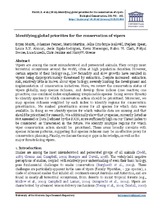| dc.contributor.author | Maritz, Bryan | |
| dc.contributor.author | Penner, Johannes | |
| dc.contributor.author | Martins, Marcio | |
| dc.date.accessioned | 2018-10-03T14:37:09Z | |
| dc.date.available | 2018-10-03T14:37:09Z | |
| dc.date.issued | 2016 | |
| dc.identifier.citation | Maritz, B. et al. (2016). Identifying global priorities for the conservation of vipers. Biological Conservation, 204: 94 – 102. | en_US |
| dc.identifier.issn | 0006-3207 | |
| dc.identifier.uri | http://dx.doi.org/10.1016/j.biocon.2015.05.004 University | |
| dc.identifier.uri | http://hdl.handle.net/10566/4092 | |
| dc.description.abstract | Vipers are among the most misunderstood and persecuted animals. They occupy most terrestrial ecosystems around the world, often at high population densities. However, certain aspects of their biology (e.g., low fecundity and slow growth) have resulted in vipers being disproportionately threatened by extinction. Despite increased extinction risk, relatively little is known about viper biology, severely limiting the development and implementation of conservation initiatives. Here, we review the conservation status of vipers globally, map species richness, and develop three indices (one reactive; one proactive; one combined index emphasising irreplaceable species facing severe threats) to identify species for which conservation action should be prioritised. Moreover, we map species richness weighted by each index to identify regions for conservation prioritisation. We ranked prioritisation scores for all species for which data were available. In doing so we identify species for which valuable data are missing and that should be prioritised for research. We additionally show that 17 species, currently listed as Not Assessed or Data Deficient by the IUCN, score sufficiently high on our Threat Index to be considered as Threatened in the future. We identify multiple regions for which viper conservation action should be prioritised. These areas broadly correlate with species richness patterns, suggesting that species richness may be an effective proxy for conservation planning. Finally, we discuss the major gaps in knowledge, as well as the
major threats facing vipers. | en_US |
| dc.language.iso | en | en_US |
| dc.publisher | Elsevier | en_US |
| dc.rights | This is the author-version of the article published online at: http://dx.doi.org/10.1016/j.biocon.2015.05.004 | |
| dc.subject | Viperidae | en_US |
| dc.subject | Conservation prioritisation | en_US |
| dc.subject | Threat Index | en_US |
| dc.subject | Ecological and Evolutionary Distinctiveness | en_US |
| dc.subject | IUCN Red List | en_US |
| dc.subject | Viper Action Plan | en_US |
| dc.title | Identifying global priorities for the conservation of vipers | en_US |
| dc.type | Article | en_US |
| dc.privacy.showsubmitter | FALSE | |
| dc.status.ispeerreviewed | TRUE | |

